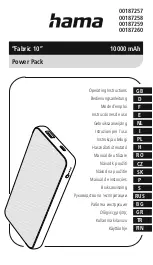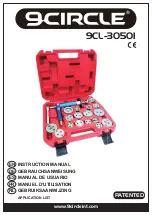
GB
- 23 -
To ensure that the battery pack provides long ser-
vice, you should take care to recharge it promptly.
You must recharge the battery pack when you
notice that the performance of the device drops.
Never allow the battery pack to become fully di-
scharged. This will cause it to develop a defect.
5.8 Battery capacity indicator (Fig. 8 /Item b)
Press the button for the battery capacity indicator
(a). The battery capacity indicator (b) shows
the charge status of the battery using 3 LEDs.
All 3 LEDs are lit:
The battery is fully charged.
2 or 1 LED(s) are lit:
The battery has an adequate remaining charge.
1 LED blinks:
The battery is empty, recharge the battery.
All LEDs blink:
The battery pack has undergone exhaustive di-
scharge and is defective. Do not use or charge a
defective battery pack!
6. Operation
6.1 On/O
ff
switch (Fig. 10/Item 3)
To switch on:
Press the locking button (2) and the On/O
ff
switch
(3).
In
fi
nitely variable stroke speed control is possible
with the On/O
ff
switch (3). The further you push
the switch, the higher the stroke speed.
To switch o
ff
:
Release the locking button (2) and the On/O
ff
switch (3).
6.2 Setting the pendulum action
(Fig. 11/Item 7)
The strength of the pendulum action of the saw
blade (10) can be adjusted using the selector
switch for pendulum action (7).
You can adjust the cutting speed, cutting perfor-
mance and appearance of the cut to the workpie-
ce you want to saw.
Set the selector switch for pendulum action (7) to
one of the following positions:
Position A
= no pendulum action
Material:
Rubber, ceramic, aluminium, steel
Please note:
For
fi
ne and clean cuts, thin materi-
als (e.g. sheet steel) and hard materials.
Position B
= small pendulum action
Material:
Plastic, wood, aluminium
Please note:
For hard materials.
Position C
= medium pendulum action
Material:
Wood
Position D
= large pendulum action
Material:
Wood
Please note:
For soft materials and sawing along
the grain
The best combination of speed and pendulum
action depends on the material you want to saw.
We recommend you to make a trial cut on a waste
piece in order to check the ideal settings.
6.3 Making cuts
Caution!
•
Make sure that the On/Off switch (3) is not
depressed. Only then should you connect the
battery pack to the equipment.
•
Do not switch on the jigsaw until you have
fitted a saw blade.
•
Use only saw blades that are in perfect con-
dition. Replace blunt, bent or cracked saw
blades immediately.
•
Place the saw foot flat on the workpiece you
want to saw. Switch on the jigsaw.
•
Allow the saw blade to accelerate until it
reaches full speed. Then slowly move the saw
blade along the cutting line. Exert only gentle
pressure on the saw blade as you do so.
•
When cutting metal, apply a suitable coolant
along the line you want to cut.
6.4 Sawing out sections (Fig. 12)
Drill a 10 mm hole in the section you want to saw
out. Insert the saw blade into this hole and start to
saw out the required section.
6.5 Miter cuts
•
Set the angle on the soleplate (see section
5.4).
•
Observe the instructions in section 6.3.
•
Cut as shown in Fig. 9.
Anl_TC_JS_18_Li_SPK7.indb 23
Anl_TC_JS_18_Li_SPK7.indb 23
24.07.2020 06:48:32
24.07.2020 06:48:32










































